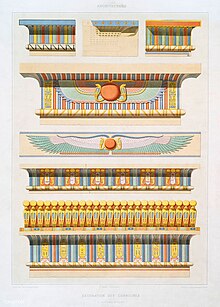
Back Rafe AN Gzimsos BAT-SMG Карніз Byelorussian Карніз BE-X-OLD Корниз Bulgarian Cornisa Catalan Římsa Czech Gesims Danish Gesims German Kornico (arkitekturo) Esperanto


In architecture, a cornice (from the Italian cornice meaning "ledge"[1]) is generally any horizontal decorative moulding that crowns a building or furniture element—for example, the cornice over a door or window, around the top edge of a pedestal, or along the top of an interior wall. A simple cornice may be formed just with a crown, as in crown moulding atop an interior wall or above kitchen cabinets or a bookcase.
A projecting cornice on a building has the function of throwing rainwater free of its walls. In residential building practice, this function is handled by projecting gable ends, roof eaves and gutters. However, house eaves may also be called "cornices" if they are finished with decorative moulding. In this sense, while most cornices are also eaves (overhanging the sides of the building), not all eaves are usually considered cornices. Eaves are primarily functional and not necessarily decorative, while cornices have a decorative aspect.
A building's projecting cornice may appear to be heavy and hence in danger of falling, particularly on commercial buildings, but often may actually be very light, made of pressed metal.
- ^ Compare Harper, Douglas. "cornice". Online Etymology Dictionary. Retrieved 19 May 2019.
© MMXXIII Rich X Search. We shall prevail. All rights reserved. Rich X Search